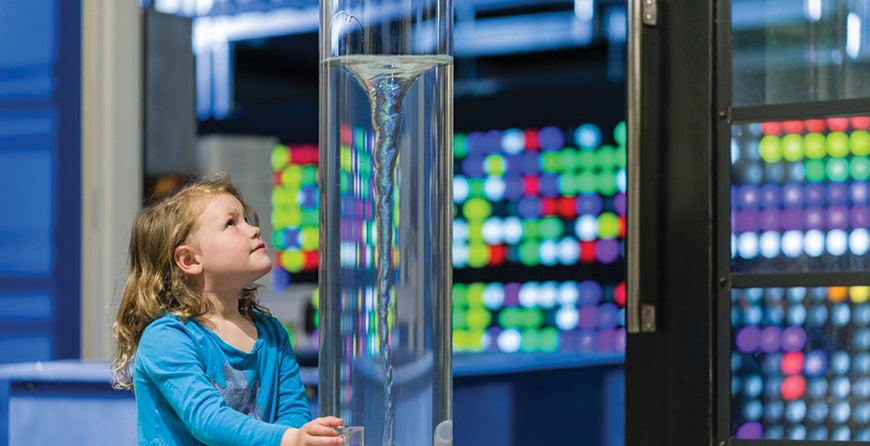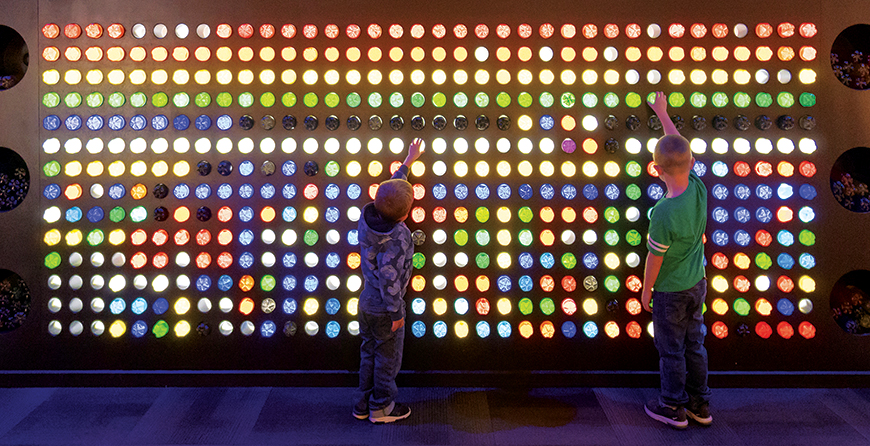Rockets! Dinosaurs! Slime!
The Discovery Center of Idaho, abutting Julia Davis Park in Boise, is a hands-on, STEM-based (science, technology, engineering, and math) slice of heaven for any child, as well as for the young at heart. Its ever-changing exhibits have featured such kid pleasers as water rockets, a giant light board, virtual reality sand, a shadow wall, a TV weathercaster green screen, a bubble wall that blows bubbles twice the size of a person, a DaVinci exhibition featuring working models derived from the artist and inventor’s notes, and a paper airplane trajectory through series of suspended rings—all based on solid science.
“Exhibitions are everything to us,” said Executive Director Eric Miller. “I focus heavily on creating exhibits so we have something new and exciting every six months that people want to come back to.”
Miller, who has a background in art and museum exhibitions, is prolific in dreaming up exhibits that not only are fun to interact with but that are educational as well. While the Discovery Center does rent traveling exhibitions such as “Bodies Human” and “DaVinci The Exhibition,” they prefer to construct exhibitions in-house that are 100 percent interactive. Most times, the Center does its own “design build,” which means that whatever Miller can imagine, his staff will build into a working exhibit in its fully equipped workshop funded by the Micron Foundation. “We believe in learning through play!” exclaimed Miller. “I design and build and am very proficient at knowing what we have the capacity to produce.”

Exploring the behavior of fluids at the Discovery Center of Idaho. Photo courtesy Discovery Center of Idaho.
It takes a unique skillset to build exhibits that allow children to explore why and how things work. “The exhibits must last for a long time, and the materials must be safe for kids,” Miller explained. The Center employs a carpenter and a fabricator to bring the exhibits from the drawing board to interactive life.
The individual exhibits must meet a rigorous set of criteria: they must be buildable within a particular timeframe, fit within the existing building, be hands-on interactive and STEM-based, be what people want to see, and, most important of all, not pinch little fingers.
A content developer assists with the educational signage on each exhibit. The signage has three components: environmental graphics, which set the tone of the exhibit with graphics and color; interpretive panels, which convey principles or ideas; and instructional signage, which shows visitors how to use the exhibit and what the result will be.
Proving that fun and science are not just for kids, the Discovery Center’s Adult Nights sell out quickly. The evenings focus on a science theme, such as last October’s Science of Fear, which featured forensics highlights and speakers from the Ada County Coroner’s office. Beer and wine are available at these events. Quipped Miller, “Last year we had a ‘Brew with Sue’ (the T-Rex), and this year we’ll have a ‘Drink with Tink!’ (a baby T-Rex).” To appreciate the playfulness and sense of fun of the staff, one need only read the fun facts listed after staff names on the website directory. For example, one reads, “Sphenopalatine ganglioneuralgia is the scientific name for brain freeze!”
In May, an exhibition of little plastic bricks that fasten together (commercially known as Legos) will feature a 12-foot rocket and a musical note system that produces a melody based on where you place the little bricks on a sheet that’s fed into the mechanism. The exhibit’s motor runs on air and was created by the in-house 3-D printer. In December, fans of the T-Rex named Sue will get to make the acquaintance of her (unofficial) offspring: a baby T-Rex named Tinker. And, in July 2020, “Slime” returns!
“Slime” was the most popular component of the 2018 exhibition “Matter Splatter” that the Center constructed in collaboration with content experts from Boise State University and Micron. “That kind of collaboration for the benefit of the community is one of the reasons I’m working here,” said Development Director Alissa Korsak, who holds a doctorate in environmental science from the University of Idaho and did microbiology research through a NASA grant before coming to the Discovery Center.
The Center plans to begin a capital campaign in the next year and expand its current 11,000 square feet of space to 20,000. It is working with the city of Boise to build in the lot next to the existing building and to eventually replace the old building with a new one.
In the meantime, there are kids’ camps, birthday party themes, and story times for young discoverers
to explore.

